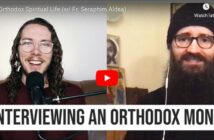Source: Orthodox Observer

Definition of a few terms used in this reflection:
*Symantron– a large wooden plank held in the player’s left hand and rhythmically struck with a wooden mallet, calling the monastic family to worship
*Koumboskini– a prayer rope made up of woven knots, with each knot corresponding to one Jesus prayer (Lord Jesus Christ, Son of God, have mercy on me, sinner.”)
In the first of this short series of reflections on the connection of the monastic family and the family living in the world, I focused on the primary function of the family, that is, to recognize and honor Christ, who is always in our midst, in every nook and cranny. In order to do this, we must have eyes to see Him; and the path to seeing Him is prayer, both personal and communal.
In the monastery, I was constantly reminded of prayer, beginning with the symantron, which woke me up every morning, reminding me that it was time for worship, usually Matins followed by the First Hour and Divine Liturgy. Then, several times more each day, the family would be called to worship at the designated hours. Throughout the day, both indoors and out, I had constant reminders of the presence of Christ in icons, mosaics, and crosses, all of which encouraged me to pray. Furthermore, the sisters carried a koumboskini (some visible, some not), a constant reminder of prayer of the heart, the Jesus prayer. Finally, and most significant for me, even when the sisters were working or in conversation with one another or visitors, an “infectious” spirit of prayer was ever present. The family lived and believed the words of St. Paul in Philippians 4.6: “Do not worry about anything, but in everything by prayer and supplication with thanksgiving let your requests be made known to God.”
I was particularly moved the third time I visited the monastery, when one of the sisters asked me by name about every one of the people I had previously asked her to pray for. She even remembered the needs I had indicated to her for about 15 different people or families! I later learned that she carried a prayer list in the pocket of her robe and prayed for everyone on that list daily.
So, publicly, the entire monastic family was a constant witness of the practice of prayer. However, following the teaching of our Lord, “But whenever you pray, go into your room and shut the door and pray to your Father who is in secret; and your Father who sees in secret will reward you,”(Mt. 6:6), another side of prayer was always present behind the scenes. As I came to learn, each of the sisters has a personal rule of prayer she is to follow in her “cell,” that is, the room where she prays and sleeps.
So, what can we learn about family prayer from a monastic family?
The importance of visible reminders of the presence of Christ, which prompt us to pray. A prayer corner — with icons, a candle, censor, cross, and other items–is essential in an Orthodox Christian home. Additionally, reminders in every room of the house are also essential. So, a cross, icon, “gratitude jar,” collection jar for the needy, candles, and other things that prompt us to pray and embody prayer in the way we live are important in every room of our homes.
Specific times of personal and family prayer each day and regular attendance at worship. The “face” of these practices will vary from family to family. Some possible practices include:
- prayer at meals
- reading Scripture and/or the life of a saint of the day at the breakfast or dinner table
- a family morning and/or evening rule of prayer (age appropriate)
- a shortened Vespers, Compline or Paraclesis service weekly or monthly
- censing/blessing each room of the house while chanting a hymn – daily, weekly, monthly
- personal practice of silence before the icon of Christ or the Theotokos (even young children can do this for 1-5 minutes). In our home with our grandchildren, we call it “sitting with Jesus”
- prayer before travelling, an event in the life of someone in the family (exam, interview, performance, athletic event, etc)
- a gratitude/thanksgiving jar, where each member of the family contributes daily or weekly with a written note of something he/she is thankful to God for and the family gathers to read from time to time
- personal “rule” of prayer for each member of the family (age appropriate). May be as simple as praying the Lord’s prayer alone each day before the day begins or at the end of the day or praying the Jesus prayer with a short prayer rope once a day
- Intercessory prayer for those in need—the family can even keep a running list as a reminder
The key is, we learn to pray by praying, and the earlier we begin a regular and consistent practice of prayer in our lives, the more likely we will become people of prayer.
Family Challenge: Have a family meeting where you discuss the practice of prayer in your home—personal and family prayer and worship—what you presently do and how you can adjust what you are doing to grow your prayer life. After a few weeks have passed, have another family meeting to discuss the progress each person and the family have made, ending with a prayer of Thanksgiving. You can find three kid-friendly Thanksgiving prayers at: http://www.orthodoxmom.com/2012/11/22/thanksgiving-prayers/.
Presvytera Kerry Pappas is the Seminarian and Clergy Couple Care Coordinator for the GOA Center for Family Care.




1 Comment
This may be the best article the GOA has ever produced. This presbytera should be put on a national speaking tour; exceptional work.